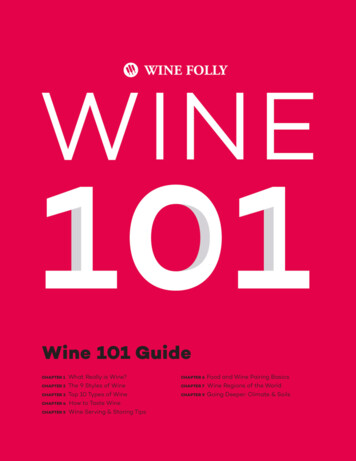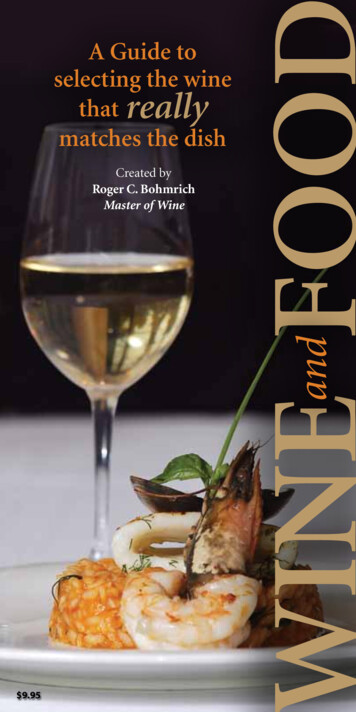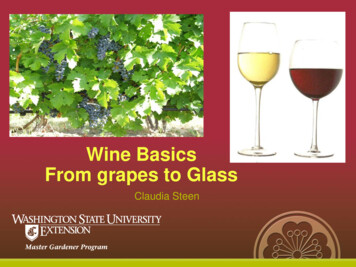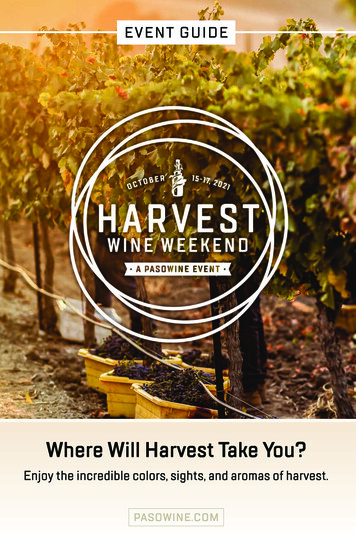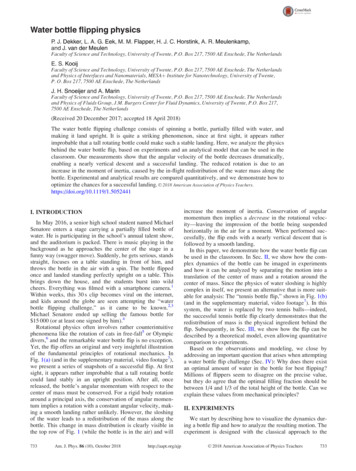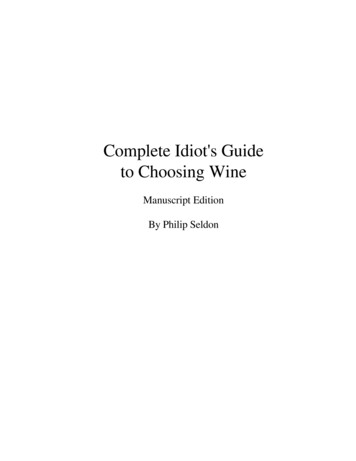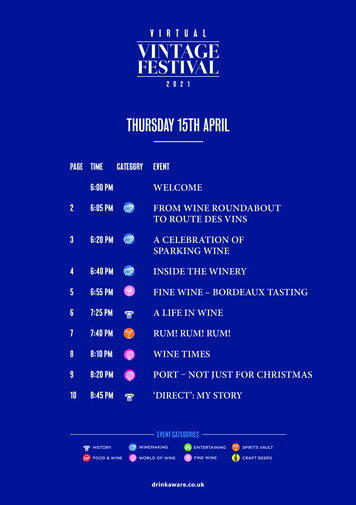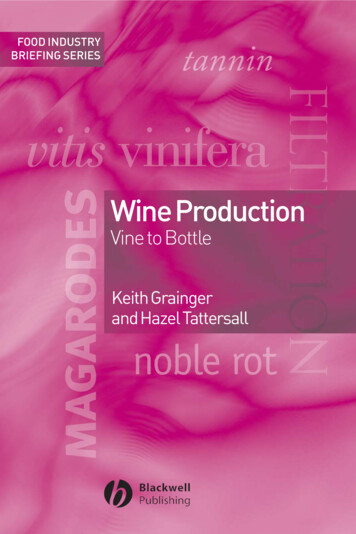
Transcription
FOOD INDUSTRYBRIEFING SERIESWine ProductionVine to BottleKeith Graingerand Hazel Tattersall
Food Industry Briefing SeriesWINE PRODUCTION: VINETO BOTTLEKeith GraingerandHazel Tattersall
K. Grainger & H. Tattersall 2005Blackwell Publishing LtdEditorial Offices:Blackwell Publishing Ltd, 9600 Garsington Road, Oxford OX4 2DQ, UKTel: 44 (0)1865 776868Blackwell Publishing Professional, 2121 State Avenue, Ames, Iowa 50014-8300, USATel: 1 515 292 0140Blackwell Publishing Asia Pty Ltd, 550 Swanston Street, Carlton, Victoria 3053, AustraliaTel: 61 (0)3 8359 1011The right of the Author to be identified as the Author of this Work has been assertedin accordance with the Copyright, Designs and Patents Act 1988.All rights reserved. No part of this publication may be reproduced, stored in a retrievalsystem, or transmitted, in any form or by any means, electronic, mechanical,photocopying, recording or otherwise, except as permitted by the UK Copyright,Designs and Patents Act 1988, without the prior permission of the publisher.First published 2005 by Blackwell Publishing LtdLibrary of Congress Cataloging-in-Publication DataGrainger, Keith.Wine production : vine to bottle/Keith Grainger and Hazel Tattersall.p. cm. — (Food industry briefing series)Includes bibliographical references and index.ISBN-13: 978-14051-1365-6 (pbk.: acid-free paper)ISBN-10: 1-4051-1365-0 (pbk.: acid-free paper)1. Wine and wine making. I. Tattersall, Hazel. II. Title. III. Series.TP548.G683 2005641.2′2—dc222005005238ISBN-13: 978-14051-1365-6ISBN-10: 1-4051-1365-0A catalogue record for this title is available from the British LibrarySet in 10/13pt Franklin Gothic Bookby Integra Software Services Pvt. Ltd, Pondicherry, IndiaPrinted and bound in Indiaby Replika Press Pvt. LtdThe publisher’s policy is to use permanent paper from mills that operate a sustainableforestry policy, and which has been manufactured from pulp processed usingacid-free and elementary chlorine-free practices. Furthermore, the publisher ensuresthat the text paper and cover board used have met acceptable environmentalaccreditation standards.For further information on Blackwell Publishing, visit our website:www.blackwellpublishing.com
ContentsSeries Editor’s ForewordPrefaceAcknowledgementsIntroductionChapter 1 Viticulture – The Basics1.1 The structure of the grape berry1.1.1 Stalks1.1.2 Skins1.1.3 Yeasts1.1.4 Pulp1.1.5 Pips1.2 The grape vine1.3 What is a grape variety?1.4 Reasons for grafting1.5 Phylloxera vastatrix1.6 Rootstocks1.7 The lifespan of the vineChapter 2 Climate2.1 Climatic requirements of the grape vine2.1.1 Sunshine2.1.2 Warmth2.1.3 Cold winter2.1.4 Rainfall2.2 Climatic enemies of the grape vine2.2.1 Frost2.2.2 Hailixxiixivxv11222344567911121212131313141414iii
WINEPRODUCTIONiv2.2.3 Strong winds2.2.4 Excessive heat2.3 Mesoclimate and microclimate2.3.1 Water2.3.2 Altitude2.3.3 Aspect2.3.4 Woods and trees2.4 The concept of degree days2.5 Impact of climate2.6 WeatherChapter 3 Soil3.1 Soil requirements of the grape vine3.1.1 Good drainage3.1.2 Fertility3.1.3 Nutrient and mineral requirements3.2 Influence of soils upon wine styleand quality3.3 Soil types suitable for viticulture3.4 Soil compatibility3.5 TerroirChapter 4 The Vineyard4.1 Vineyard location4.2 Density of planting of vines4.3 Training systems4.3.1 Main types of vine training4.3.2 Other training systems4.4 Pruning methods and canopy management4.5 Irrigation4.6 The growing season and work in thevineyardChapter 5 Pests and Diseases5.1 Important vineyard pests5.2 Diseases5.3 Prevention and 242526262930313234343638
vEnvironmental Approaches in the Vineyard6.1 Integrated pest management (IPM)6.2 Organic viticulture6.3 Biodynamic viticultureChapter 7The Harvest7.1 Grape ripeness and the timing of picking7.2 Harvesting methods7.2.1 Hand picking7.2.2 Machine picking7.3 Style and qualityChapter 8Vinification – The Basics8.1 Basic principles of vinification8.2 Winery location and design8.3 Winery equipment8.3.1 Fermentation vatsChapter 9Red Wine Making9.1 Destemming and crushing9.2 Must preparation9.3 Fermentation, temperature control and extraction9.3.1 Fermentation9.3.2 Temperature control9.3.3 Extraction9.4 Maceration9.5 Racking9.6 Pressing9.7 Malolactic fermentation9.8 Blending9.9 MaturationChapter 10 Dry White Wine Making10.1 Crushing and pressing10.1.1 Crushing10.1.2 5858595960606062626262CONTENTSChapter 6
WINEPRODUCTIONvi10.210.310.410.5Must preparationFermentationMalolactic fermentationMaturation63636464Chapter 11 Preparing Wine for Bottling6511.1 Fining11.2 Filtration11.2.1 Earth filtration11.2.2 Sheet filtration11.2.3 Membrane filtration11.3 Stabilisation11.4 Adjustment of sulphur dioxide levels11.5 Bottling11.6 ClosuresChapter 12 Detailed Processes of Red and WhiteWine Making12.1 Wine presses and pressing12.1.1 Continuous press12.1.2 Batch press12.1.3 Horizontal plate press12.1.4 Horizontal pneumatic press12.1.5 Vertical basket press12.2 Use of gases to prevent spoilage12.3 Natural or cultured yeasts12.4 Destemming12.5 Fermenting sugar-rich musts to dryness12.6 Colour extraction, concentration andtannin balance12.6.1 Must concentrators and reverse osmosis12.6.2 Cold soaking (pre-fermentationmaceration)12.6.3 Pump overs12.6.4 Rack and return (délestage)12.6.5 Rotary vinifiers12.6.6 Thermo-vinification – heat extraction12.6.7 Whole grape fermentation, carbonic andsemi-carbonic maceration12.6.8 Fixing 81818183838384
12.6.9 Post-fermentation maceration12.7 Macro-, micro- and hyper-oxygenation12.7.1 Hyper-oxygenation12.7.2 Macro-oxygenation12.7.3 Micro-oxygenation12.8 Removal of excess alcoholChapter 13 Barrel Maturation and Oak Treatments13.1 The influence of the barrel13.1.1 Size of the barrel13.1.2 Type and origin of oak (or anyother wood)13.1.3 Manufacturing techniques, includingtoasting13.1.4 Amount of time spent in barrel13.1.5 Where barrels are stored13.2 Oak treatmentsChapter 14 Making Other Types of Still Wine14.1 Medium-sweet and sweet wines14.1.1 Medium-sweet wines14.1.2 Sweet wines14.2 Rosé wines14.3 Liqueur (fortified) wines14.3.1 Sherry production14.3.2 Port production14.3.3 Other well-known liqueur winesChapter 15 Sparkling Wines15.1 Fermentation in sealed tank15.2 Second fermentation in bottle15.3 The traditional method15.3.1 Pressing15.3.2 Débourbage15.3.3 First fermentation15.3.4 Assemblage15.3.5 Addition of liqueur de tirage15.3.6 Second fermentation15.3.7 949596979797989899999999100100CONTENTSvii
2RémuageStacking sur pointesDégorgementDosage (liqueur d’expedition)CorkingChapter 16 Problems and Solutions16.1 Vintages – style and quality16.2 Coping with problems in the vineyard16.3 Handling fruit in the winery16.4 Problems in winemaking16.4.1 Delay in processing fruit16.4.2 Lack of fruit selection16.4.3 Problems with crushing, destemming orpressing16.4.4 Lack of control of fermentations16.4.5 Delays in post-fermentation racking16.4.6 Lack of attention to barrels16.4.7 Poor or over-filtration16.4.8 Careless bottlingChapter 17 Common Faults and their ichloroanisoleOxidationExcessive volatile acidityExcessive sulphur minGlossaryBibliographyUseful 122124127
Series Editor’s ForewordIn the old wine producing countries and regions of Europe, winehas been easily available for generations and is a well establishedpart of the dietary cultures of many nations. In more recent timesthe beverage has increased its visibility in the diets of people incountries not blessed with an indigenous wine industry, and thechange is still underway. Now wines produced in the many, andincreasing number of, wine producing regions of the world are beingexported globally. Consumers from widely differing socio-economicgroups are able to experience wine, and no longer can it be thoughtof as the preferred beverage of the privileged classes. Wine hascome of age in the modern consumer marketplace. It is somethingthat is enjoyed by all kinds of consumers, often at the expense ofother beverages.A great deal of the credit for what we might term the democratisation of wine must go to New World wine producers in countriessuch as Australia, New Zealand, California and South Africa, aswell as some adventurous Old World producers. They have workedhard over many years to produce high quality wines that appeal tomodern tastes, and have developed highly efficient and flexibledistribution networks that serve a global food marketplace. Thissaid, credit must also go to the supermarkets which have helpedto develop the consumers’ interest in wine, significantly by creatingways to inform people about wine. No longer does one have to bean expert to find and enjoy a drinkable wine. A great deal of usefulinformation is now routinely provided on bottle labels and supermarket shelves, thus guiding judgement, easing decision making,and increasing the likelihood that the money spent on a bottle ofwine will be rewarded by the liquid in the bottle. Some peoplethough, wish to know more about wine than can be found onix
WINEPRODUCTIONxthe bottle or in the supermarket, or even conveyed by the TV wineexpert. They need, therefore, to delve into appropriate texts, andthis book has been written for them, irrespective of whether theirinterest is that of the enthusiastic amateur or at a more professionallevel.Wine Production: Vine to Bottle has been written by two veryexperienced wine educators, who have drawn on many years ofpractical involvement with the wine industry. They have created awork that fits well between the coffee table publications thataccompany TV programmes and the specialist books written forviticulturalists and oenologists. It will be of great value to thosewho wish to understand what wine is and how it is produced –from vine to bottle. It will also provide a very firm foundation forthe development of specialist knowledge of the topic for thosewho wish to make a serious study of wine. It makes an idealstarting point for a process of study which gradually takes inmore advanced publications. In this respect, the authors, KeithGrainger and Hazel Tattersall, have intentionally set out to produce a readily accessible text which can be easily read andefficiently assimilated. As editor of the work, I can see they haveachieved their objective, and I am sure the book will be of use toprofessionals and non-professionals alike. Indeed, I am sure thatthose with an interest in wine production as well as those who workin the wine industry will find the book of great utility. Also, I expect itto be of importance to academics and students in fields rangingfrom food science and technology to hospitality management andfood service.This book is the third publication in Blackwell’s Food IndustryBriefing Series and it makes a worthy contribution as it deals witha specific product type. The series was created to provide peoplewith an interest in food production and processing, and food scienceand technology, with condensed works that can be read quickly. Theseries is of particular benefit to busy food industry professionals whodo not have the time to tackle heavy texts, but who wish to gainknowledge easily on certain topics. The series will also be of benefitto academics who may use the books to support courses andmodules, as well as students studying the subjects of food and drink.In this respect it has been Blackwell’s intention to keep the bookssensibly priced, so that students can afford to buy their own copies,and college and university libraries can extend to multiple ownership.
EDITOR’SRalph EarlySeries Editor, Food Industry Briefing SeriesHarper Adams University CollegeSERIESIn an age when textbooks and journals are being priced out ofthe academic market, ensuring access to learning through a sanecost structure is important and the publishers must be commendedfor this.FOREWORDxi
PrefaceThere are, of course, many detailed books on the topics of grapegrowing and winemaking, and the multifarious individual aspectsthereof. These books, although very valuable to oenology students,grape growers and winemakers, are often highly technical. There arealso several ‘coffee table’ books, which paint a picture that will beappreciated by consumers and those with merely a passing interest.Our aim in writing this book is to provide a concise, structured yetreadable, understanding of wine production, together with a basicsource of reference.Although the book contains necessary scientific information, itis designed to be easily understood by those with little scientificknowledge. As such, it may prove valuable to food and beverageindustry professionals, wine trade students, wine merchants,sommeliers and restaurateurs, those entering (or thinking of entering)the highly competitive world of wine production, and all seriouswine lovers.The information contained herein is not from any parochial orpolarised viewpoint, although the authors, like all wine lovers,cannot (and do not wish to) claim to be totally objective. Duringthe research and preparation we have spent much time in wineregions in both the New World and Old. We obtained diverseand detailed viewpoints from hundreds of practitioners, includinggrowers and vineyard workers in both cool and hot climates,family winery owners, winemakers and technicians working withlarge scale producers, consultants and representatives of wineinstitutes.We wish to thank everybody who gave us their valuable time andwere happy to share their knowledge and opinions. We also wish tothank Ralph Early, series editor for the Food Industry Briefing books,xii
for his valuable suggestions and work on editing the text, and NigelBalmforth and Laura Price of Blackwell Publishers who have givenus the opportunity to produce this work.Keith GraingerHazel TattersallPREFACExiii
AcknowledgementsWe are grateful to the following people and organisations forpermission to use the figures identified here:Christopher Willsmore, Warwickshire for Figs. 1.1, 1.3, 1.4 and 4.1.Corinne Delpy, Yaslin Bucher S.A., Chalonnes-sur-Loire, France, forFigs. 9.1 and 12.2.Mauro Ricci, Della Toffola S.p.A., Signoressa di Trevignano, Italy, forFig. 11.4.Nicola Borzillo, REDA S.p.A., Isola Vicentina, Italy, for Fig. 12.5.Lynn Murray, Champagne Taittinger & Hatch Mansfield Agencies,Ascot for Fig. 15.1.Frédérick Questiaux, Oeno Concept S.A., Epernay, France, forFig. 15.2.xiv
IntroductionNo other beverage is discussed, adored or criticised in the sameway as wine. To a few, it is something to be selected with the greatestof care, laid down until optimum maturity, carefully prepared forserving, ritually tasted in the company of like-minded people usinga structured technique and then analysed in the manner of both theforensic scientist and literary critic. To many, it is simply the bottlebought in the supermarket according to the offer of the moment,drunk and perhaps enjoyed on the same day as purchased. To thosefavoured with living in wine producing regions it is often the beveragepurchased from the local producers’ cooperative from a dispenserresembling a petrol pump, taken home in a five or ten litre containersand drunk with every meal.There is a wonderful diversity in the styles and quality of winesproduced throughout the world, promoting discussion and disagreement amongst wine lovers. The wines of individual producers, regionsand countries rise and fall in popularity according to consumer andpress and TV media perceptions of style, quality, fashion and value.Consumers do not remain loyal when they perceive that their needsand wants are better met elsewhere. In the 1980s, wines fromBulgaria were very popular in the United Kingdom and Australianwines almost unheard of. By 2005 the wines of Australia held thetop position in the UK market, by both volume and value of sales.Few would dispute that the standard of wines made today ishigher than at any time in the 8000 years or so of vinous history.The level of knowledge of producers, and thus the ability to controlthe processes in wine production, could only have been dreamt ofeven 40 years ago. Yet when Decanter magazine compiled a list ofthe greatest wines of all time in August 2004, the top position wasawarded to Château Mouton Rothschild 1945, and six of the ‘topten’ wines were produced more than 40 years ago. Also, in the pastxv
WINEPRODUCTIONxvifew years, globalisation and consolidation of producers have perhapshad the detrimental effect of producing technically good wines whosestyles have become standardised. In other words, the wonderfuldiversity we referred to is under threat.This book details how wine is produced, from vine to bottle. Manyof the concepts are simple to grasp, others more complex. However,we need to stress at this stage that there is no single, unquestionedapproach to wine production. Many procedures in common usageremain subject to challenge. Indeed, if you talk to 50 winemakersyou are likely to hear a hundred different viewpoints, and manyproducers are constantly experimenting and changing techniques.In considering wine production, there are two distinct stages:the growing of grapes (viticulture) and turning grapes into wine(vinification).Throughout the wine producing world there are many in the industry,and many businesses, that carry out just one of these stages:growers who make no wine but sell their grapes to a wine producingfirm, or who are members of a cooperative that makes wine. Thenthere are wine producers who have no vineyards, or insufficient tosupply their grape needs, who buy grapes from growers small or large.The decisions made and operations undertaken in both the vineyard and winery will impact upon the style and quality of the finishedwine. These decisions will be based on numerous factors: geographical,geological, historical, legal, financial and commercial. The resourcesand availability and cost of local labour will have a major impactupon the decisions made and the structure of the wine productionoperation. Both the grower and the winemaker are aiming for maximumcontrol: yield, quality, style and cost. Of course, the aim is to makea profit.Grapes contain all that is basically necessary to make wine: thepulp is rich in sugar and yeasts are contained in the bloom whichlooks like a white powder on the skins. However, many winemakerschoose to inhibit these natural yeasts and use cultured yeasts forfermentations. It should be noted that, unlike in the production ofbeer (and many spirits), water is not generally used as an ingredientin winemaking. The grapes should be freshly gathered, and ideallythe winemaking should take place in the district of origin. However,this is not always adhered to, particularly with regard to inexpensivewines. It is not uncommon for grapes or grape must to travel fromone region to another, or sometimes even to another country, priorto fermentation.
Wine is, of course, alcoholic. The alcohol in wine is ethanol, otherwise known as ethyl alcohol. Although it is a natural product, ethanolis toxic, and can damage the body if taken in excess. The alcohol isobtained from the fermentation of must (see Box I.1), by the actionof enzymes of yeast which convert the sugar in the must into ethanoland carbon dioxide.Box I.1Definition of mustMust: Grape juice and solids before fermentation.Although the fermentation lies at the heart of winemaking, everyother operation will impact upon the finished wine. The entire production process may take as little as a few weeks for inexpensivewines, or two years or more for some of the highest quality wines. Inthe case of some liqueur (fortified) wines, the production processmay take over a decade.Quote: ‘If you ask me: “Have you made the best wine, or the bestwine that you can?” and I answer “Yes”, then you must take me awayand bury me.’ Beyers Truter, South African winemaker, famed formaking perhaps the best Pinotage in the world.INTRODUCTIONxvii
This page intentionally left blank
Viticulture – The BasicsThe harvesting of healthy, ripe grapes is the end of a successful annualvineyard cycle and the beginning of the work in the winery. The growerand winemaker are both aware that any deficiencies in the quality offruit will affect not only quality but also profitability. Although the juice ofthe grape is seen as the essential ingredient in the winemakingprocess, other constituents also have roles of varying importance.1.1The structure of the grape berryFig. 1.1 shows a section through a typical grape berry.StemSkinPipFig. 1.1PulpBloomStructure of the grape berry1
WINEPRODUCTION21.1.1StalksStalks contain tannins that may give a bitter taste to the wine. Thewinemaker may choose to destem the grapes completely before theyare crushed. Alternatively, the stalks, or a small proportion of them,may be left on to increase the tannin in red wine to give extra structure. However, if the stalks are not removed, they perform a usefultask in the pressing operation by acting as drainage channels.1.1.2SkinsSkins contain colouring matters, aroma compounds, flavour constituents and tannins. The outside waxy layer with its whitish hue iscalled bloom. This contains yeasts and bacteria. Below this we findfurther layers containing complex substances called polyphenols,which can be divided into two groups:(1)(2)1.1.3Anthocyanins (black grapes) and flavones (white grapes) givegrapes their colour and as phenolic biflavanoid compoundsthey form antioxidants and thus give health-giving propertiesto wine.Tannins are bitter compounds that are also found in stalksand pips. They can, if unripe or not handled correctly, givedried mouth feel on the palate. Tannin levels are higher in redwines where more use is made of the skins and stalks in thewinemaking and with greater extraction than in white androsé wines. Some varieties such as Cabernet Sauvignon, Syrahand Nebbiolo contain high levels of tannins, others such asGamay have much lower levels.YeastsYeasts are naturally occurring micro-organisms which are essentialin the fermentation process. Yeasts attach themselves to the bloomon the grape skins. There are two basic groups of yeast present onthe skins: wild yeasts and wine yeasts. Wild yeasts (mostly of thegenus Klöckera and Hanseniaspora), need air in which to operate.Once in contact with the grape sugars, they can convert thesesugars to alcohol, but only up to about 4% alcohol by volume (ABV),
1.1.4PulpThe pulp or flesh contains juice. If you peel the skin of either a greenor black skinned grape, the colour of the flesh is generally the same.The actual juice of the grape is almost colourless, with the very rareexception of a couple of varieties that have tinted flesh. The pulp/flesh contains water, sugars, fruit acids, proteins and minerals. Sugars: when unripe, all fruits contain a high concentration ofacids and low levels of sugar. As the fruit ripens and reachesmaturity, so the balance changes, with sugar levels rising andacidity falling. Photosynthesis is the means by which a greaterpart of this change occurs. Grape sugars are mainly represented by fructose and glucose. Sucrose, although present inthe leaves and phloem tubes of the vine, has no significantpresence in the grape berry. As harvest nears, the producercan measure the rise in sugar levels by using a refractometer,as illustrated in Fig. 1.2.Acids: by far the most important acids found in grapes are tartaric acid and malic acid, the latter being of a higher proportionin unripe grapes. During the ripening process, tartaric acidthen becomes the principal acid. Tartaric acid is not commonlyFig. 1.2RefractometerCHAPTERat which point they die. Wine yeasts, of the genus Saccharomyces,then take over and continue to work until either there is no moresugar left or an alcoholic strength of approximately 15% has beenreached, at which point they die naturally.13
WINEPRODUCTION4 found in plants other than vines. Acids have an important rolein wine in giving a refreshing, mouth-watering taste and alsogive stability and perhaps longevity to the finished wine. Thereare tiny amounts of other acids present in grapes, includingacetic and citric.Minerals: potassium is the main mineral present in the grapepulp, with a concentration of up to 2500mg/l. Of the other minerals present, none has a concentration of more than 200 mg/l,but the most significant are calcium and magnesium.1.1.5PipsPips or seeds vary in size and shape according to grape variety.Unlike with stalks, there is no means of separating them on receptionat the winery. If crushed, they can impart astringency to the wine dueto their bitter oils and hard tannins. As we shall see later, today’smodern presses take account of this.1.2The grape vineThe grape variety, or blend of grape varieties, from which a wine ismade is a vital factor in determining the design and style of thewine. However, it is not the only factor, although many a Chardonnayor Cabernet Sauvignon drinker believes otherwise. Wines made froma single variety are referred to as varietals. The name of the varietymay be stated on the label, this concept having been introduced inAlsace in the 1920s and promoted heavily by the Californian producersin the 1970s, has now become commonplace. However, manywines made from a single variety do not state the fact on the label,e.g. a bottle of Chablis AC will rarely inform you that the wine ismade from Chardonnay, indeed the rules of Appellation Contrôléeoften do not permit the name of the grape to be stated. Many topquality wines are made from a blend of two or more varieties, witheach variety helping to make a harmonious and complex blend. Thiscan perhaps be compared with cooking, where every ingredient addsto taste and balance. Examples of well known wines made froma blend of varieties include most red Bordeaux, which are usually
1.3What is a grape variety?The grape vine belongs to a family of climbing plants calledAmpelidacae. The family comprises a number of genera, includingthe genus Vitis, which is the grape bearing vine. This genus comprises a number of species, including that of Vitis vinifera. It is worthnoting that the members of any species have the ability to exchangegenes and to interbreed. Vitis vinifera is the European and CentralAsian species of grape vine, and it is from this species that almostall of the world’s wine is made.Vitis vinifera has, as we now believe, some four thousand differentvarieties, e.g. Vitis vinifera Chardonnay, Vitis vinifera CabernetSauvignon. Each variety looks different, and tastes different. Somevarieties ripen early, others late; some are suitable for growing inwarm climates, others prefer cooler conditions; some like certaintypes of soil, others do not; some yield well, others are extremelyshy bearing. Some can produce first class wine, others distinctlymediocre. Whilst these are all factors of relevance to the grower, theactual choice of variety or varieties planted in any vineyard may well,in Europe, be determined by wine laws. These may stipulate whichvariety or varieties may be planted in a region, and which varietiesmust be used to make certain wines. For example red Beaune ACmust be made from the variety Pinot Noir. Valpolicella DOC must bemade from a blend of Corvina, Rondinella and Molinara. It is worthremembering that most of the varieties that we know have beencultivated and refined by generations of growers, although some suchas Riesling are probably the descendants of wild vines. Discussionof the characteristics of individual grape varieties is a detailed topicand is beyond the scope of this book. For further information thereader is referred to the Bibliography.CHAPTERmade from two to five different varieties, and red Châteauneuf-du-Papewhere up to 13 can be used.There are thousands of different grape varieties; the names of some,e.g. Chardonnay, are very well known. Others are largely unknown.Some varieties are truly international, being planted in many parts of theworld. Others are found in just one country, or even in just one regionwithin a country. Many varieties have different names in different countries, and even pseudonyms in different regions of the same country.15
WINEPRODUCTION6Box 1.1Definition of crossingCrossing: Variety produced by fertilising one Vitis vinifera varietywith the pollen of another Vitis vinifera variety.Box 1.2Definition of hybridHybrid: A crossing of two vine species. Illegal in the EuropeanUnion for quality wine production.It is possible to cross two varieties and thus produce a crossing,itself a new variety. For example the variety Müller-Thurgau (alsoknown as Rivaner) is a crossing bred in 1882 by Professor Müllerfrom Thurgau in Switzerland. It was once thought to be a crossing ofRiesling (mother) and Silvaner (father), although the current belief isthat the father was the variety Gutedel (also known as Chasselas).It is important not to confuse the term crossing with hybrid – seeBoxes 1.1 and 1.2.From any variety breeders can select individual clones. Clonalselection is basically breeding asexually from a single parent, aimingto obtain certain characteristics such as yield, flavour, good plantshape, early ripening, disease resistance, etc.In spite of the tremendous development with clonal selection duringthe past 20 years, most growers believe that old vines give the highest quality juice. Research on genetic modification of vines is takingplace, but at present no wine is produced from genetically modifiedplants.1.4Reasons for graftingAlthough nearly all the world’s wine is produced by various varietiesof the species Vitis vinifera, the roots o
Wine Production: Vine to Bottle has been written by two very experienced wine educators, who have drawn on many years of practical involvement with the wine industry. They have created a work that fits well between the coffee table publications that accompany TV programmes and the specialist books written for viticulturalists and oenologists.
